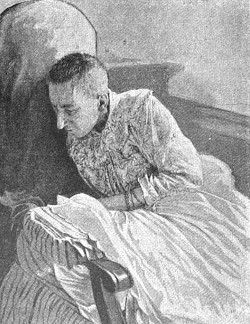A poem by Susan Thorpe:
Bells tolled,
Abbot spoke.
Wooed Abbess.
Abbey woke!
The letters in each word appear in either alphabetical or reverse alphabetical order.
(Susan Thorpe, “Alphomes,” Word Ways 28:3 [August 1995], 136-139.)
A poem by Susan Thorpe:
Bells tolled,
Abbot spoke.
Wooed Abbess.
Abbey woke!
The letters in each word appear in either alphabetical or reverse alphabetical order.
(Susan Thorpe, “Alphomes,” Word Ways 28:3 [August 1995], 136-139.)
An angel appears to a conference of philosophers and offers to provide the truthful answer to a single question. Cannily they ask:
“What is the ordered pair whose first member is the question that would be the best one for us to ask you, and whose second member is the answer to that question?”
Truthfully the angel answers:
“It is the ordered pair whose first member is the question you just asked me, and whose second member is this answer I am giving you.”
Philosopher Ned Markosian writes, “At the time the philosophers asked [the question above], it seemed like that question was the ideal one for their peculiar situation. But as it turned out, [that question] was obviously not at all the right thing to ask. … The puzzle, then, is this: What went wrong?”
(Ned Markosian, “The Paradox of the Question,” Analysis 57:2 [1997], 95-97.)
“A Brief and Somewhat Ungracious Exchange Between the British Ambassador’s Wife, Who Speaks No Spanish, and the Spanish Ambassador’s Wife, Who Speaks No English, During a Courtesy Call by the Latter Upon the Former: Written on the Assumption That My Readers Know the Sound of the Spanish Word for ‘Yes'”
“T?”
“C.”
— Willard R. Espy
A brain-hurting illusion from Reddit’s Black Magic Fuckery:

For more than 40 years in the early 20th century, Martin Couney ran a sideshow in which premature babies were displayed in incubators. With this odd practice he offered a valuable service in an era when many hospitals couldn’t. In this week’s episode of the Futility Closet podcast we’ll describe Couney’s unusual enterprise, which earned both criticism and praise.
We’ll also marvel over an Amazonian survival and puzzle over a pleasing refusal.
Express 1,000,000 as the product of two numbers, neither of which contains any zeroes.

In May 1901, the attorney general of Paris received an anonymous letter. It read, “I have the honor to inform you of an exceptionally serious occurrence. I speak of a spinster who is locked up in Madame Monnier’s house, half-starved and living on a putrid litter for the past twenty-five years — in a word, in her own filth.”
When police investigated, they found in Monnier’s attic a 52-year-old woman who weighed barely 25 kilograms. One policeman described the scene: “The unfortunate woman was lying completely naked on a rotten straw mattress. All around her was formed a sort of crust made from excrement, fragments of meat, vegetables, fish, and rotten bread. … We also saw oyster shells, and bugs running across Mademoiselle Monnier’s bed. The air was so unbreathable, the odor given off by the room was so rank, that it was impossible for us to stay any longer to proceed with our investigation.”
In 1874, when Blanche was 25, her mother Louise had locked her away to prevent her marrying a “penniless lawyer,” and for 25 years she and Blanche’s brother had pretended that she had disappeared. Louise was arrested but died shortly afterward; the brother was convicted but acquitted on appeal. Blanche was admitted to a psychiatric hospital but died in 1913. The identity of the letter writer who revealed all this was never discovered.
In his 1986 book Narration in Light, philosopher George Wilson points out an odd moment in Orson Welles’ 1947 film The Lady From Shanghai. Two men are driving hurriedly toward an important destination when a woman elsewhere learns of their journey and reacts angrily (50:55 above):
The following three-shot progression concludes the intercut series: (1) a shot from within the men’s car reveals that a truck has abruptly pulled out onto the road ahead of them; (2) the woman’s hand is shown reaching out and pressing [a] button; and (3) the men’s car collides violently with the truck.
“Viewing these shots, it appears as if the pressing of the button has mysteriously caused the accident, but, at the same time, this impression of causality is difficult to reconcile with common sense and difficult also to integrate into our immediate sense of the film’s narrative development at that juncture.” Most films settle these questions for us, but in every film our knowledge of the events is limited; “the potentiality for considerable epistemic complication always remains, and it is actually realized in some of the most interesting films ever made.”
How does an outfielder know where to run in order to catch a fly ball? Previously it had been thought that the fielder estimates the ball’s arc, acceleration, and distance; predicts where it will land; and runs straight to that spot.
“That was a really elegant solution,” Kent State psychologist Michael McBeath told the New York Times in 1995. “The only problem is that keeping track of acceleration like that is something that people are very bad at.”
McBeath and his colleagues analyzed fly balls and catches visually, mathematically, and subjectively from the players’ perspective, using a video camera. They found that fielders learn to run so that the ball follows a straight line in their visual field. “If you are faster than the critter you are trying to catch, if you can keep the prey on a simple path in your vision — hold it as if it’s moving in a straight line in your eye — then you’ll catch it.”
Among other things, this explains why fielders sometimes collide with walls when chasing uncatchable home runs. They haven’t calculated in advance where the ball will come down; instead they’re following an algorithm that’s directing them, accurately, to a landing point that’s not on the field.
(Michael K. McBeath, Dennis M. Shaffer, and Mary K. Kaiser, “How Baseball Outfielders Determine Where to Run to Catch Fly Balls,” Science 268:5210 [1995], 569-573.) (See Shortcuts.)